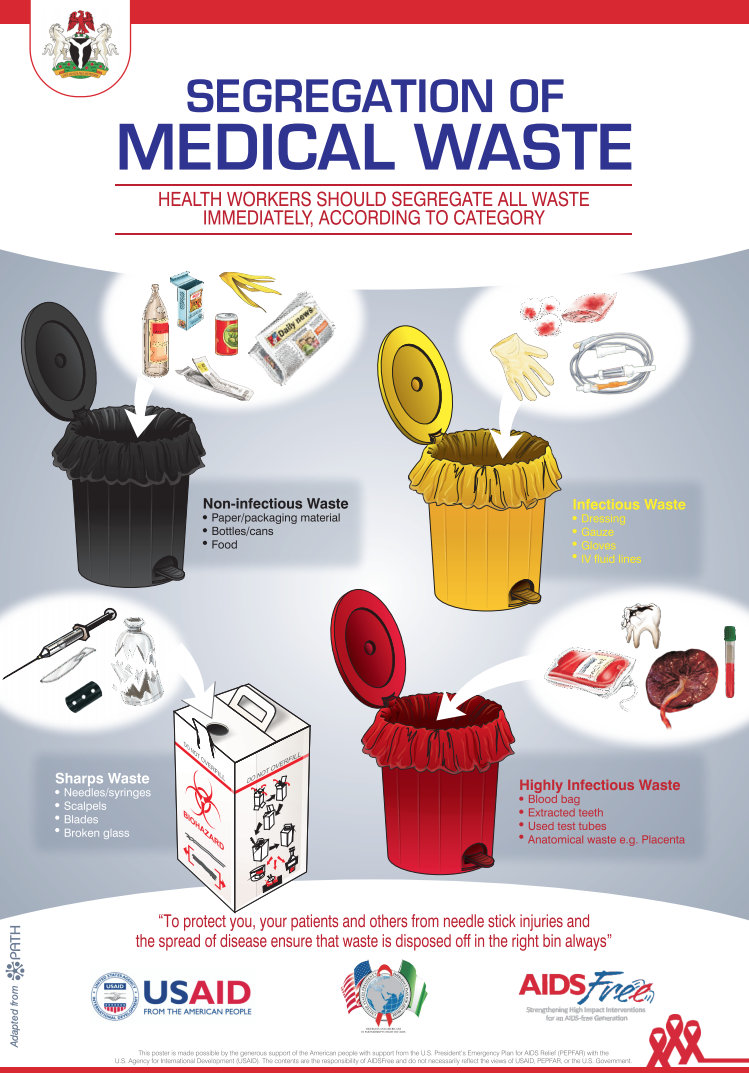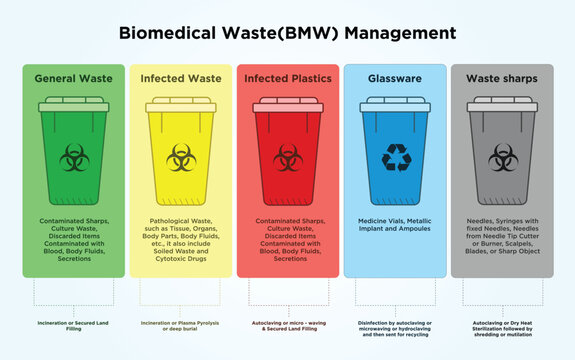Comprehensive Medical Waste Disposal Providers: Ensuring a Healthy And Balanced Atmosphere
Wiki Article
Compliance and Regulations for Medical Garbage Disposal
Compliance and regulations for clinical waste disposal play a vital function in ensuring the safety and security and health of both healthcare experts and the basic public. Appropriate administration of clinical waste is vital to prevent the spread of infections, protect the environment, and preserve public wellness. This needs adherence to particular guidelines and protocols stated by regulative companies and bodies. These laws include different aspects, consisting of the category and segregation of clinical waste, proper storage space and managing treatments, along with transportation and disposal techniques. By following these regulations, medical care facilities can reduce the threat of contamination and possible injury to individuals and the atmosphere. This short article will check out the value of compliance and supply a review of the key regulations governing medical garbage disposal.Relevance of Compliance
The relevance of conformity with laws for medical garbage disposal can not be overstated. Appropriate disposal of clinical waste is vital for guaranteeing the safety and well-being of medical care employees, clients, and the public. Medical waste, that includes products such as utilized needles, infected handwear covers, and biomedical waste, can posture significant wellness risks otherwise managed and gotten rid of properly.Compliance with policies ensures that clinical waste is managed in such a way that reduces the potential for direct exposure to unsafe materials and infectious conditions - medical waste disposal service. It assists stop the spread of infections, such as HIV, liver disease B and C, and other bloodborne microorganisms. Compliance likewise plays an important role in securing the environment by avoiding contamination of water sources, dirt, and air
Failure to abide by laws can cause extreme consequences for healthcare centers, including fines, legal activity, and damages to their online reputation. Furthermore, non-compliance may jeopardize the health and wellness of medical care workers, people, and the area.
Compliance with guidelines for medical waste disposal calls for adherence to specific standards and methods. These may consist of appropriate partition, packaging, labeling, and storage of clinical waste. It also includes making use of approved disposal methods, such as autoclaving, landfilling, or incineration, depending on the sort of waste.
Regulatory Agencies and Bodies
Regulative companies and bodies play an important function in looking after conformity with regulations for medical waste disposal. These companies are accountable for establishing standards, standards, and procedures to ensure the safe and correct handling of clinical waste. They keep an eye on and implement compliance to shield public health and wellness and the atmosphere.Among the most popular regulative firms in the USA is the Epa (EPA) The EPA is in charge of managing the storage, transport, therapy, and disposal of clinical waste. They develop guidelines for waste generators, transporters, and treatment facilities to follow, guaranteeing that all necessary precautions are taken to protect against the spread of diseases and contamination.
An additional crucial regulative body is the Occupational Security and Wellness Administration (OSHA) OSHA sets regulations and standards to secure employees from occupational dangers, consisting of those pertaining to clinical waste. WasteX Medical Waste Disposal. They give guidelines for the safe handling and disposal of clinical waste to protect employees in medical care centers
Along with these government companies, individual states additionally have their own governing bodies that supervise clinical waste disposal. These companies might have their own certain guidelines and requirements that need to be followed.

Classification and Partition of Medical Waste
To make sure proper monitoring of medical waste, it is vital to classify and segregate it according to established protocols and guidelines. medical waste removal service. Classification and segregation play a crucial function in decreasing the risk of infection, safeguarding the setting, and guaranteeing the security of medical care employees and the publicMedical waste is categorized right into various groups based on its potential danger degree. These groups consist of contagious waste, pathological waste, sharps waste, pharmaceutical waste, chemical waste, and radioactive waste. Each category needs details handling, transportation, storage, and disposal techniques to reduce the danger of exposure and contamination.
Segregation of medical waste includes separating different kinds of waste at the source. This process guarantees that waste with different hazard levels is not mixed, reducing the potential for cross-contamination and making disposal procedures more reliable. Correct segregation is attained with using color-coded labels and containers, which help healthcare workers and waste management employees manage each kind and recognize of waste appropriately.
In enhancement to category and segregation, healthcare centers need to likewise comply with neighborhood, state, and federal regulations regarding clinical waste administration. These policies outline details demands for storage, transport, treatment, and final disposal of medical waste, making sure compliance and keeping public health and wellness and safety.
Proper Storage and Handling Procedures
Correct storage space and handling procedures play a vital function in ensuring the risk-free and compliant monitoring of medical waste. Clinical waste, which consists of things such as made use of syringes, infected handwear covers, and expired medications, can position major health and environmental dangers otherwise dealt with appropriately. It is critical for medical care facilities and other generators of medical waste to apply strict storage and taking care of methods.
To begin with, medical waste ought to be stored in sturdy, leak-proof containers that are especially made for this function. These containers should be classified with the universal biohazard symbol and words "medical waste" to plainly indicate the materials. Additionally, the containers should be maintained firmly near avoid any type of possible leakage or spillage.
Moreover, it is necessary to segregate different types of clinical waste to stop cross-contamination. Sharps, such as scalpels and needles, ought to be stored in puncture-resistant containers to reduce the risk of injuries - WasteX Medical Waste Disposal. Chemical waste, such as solvents and anti-bacterials, should be stored individually from other kinds of clinical waste to avoid chemical responses or unsafe direct exposures

Transportation and Disposal Methods
Medical care facilities must ensure the secure transport and correct disposal of their medical waste to adhere to policies and secure public wellness. Transportation and disposal techniques play a vital function in stopping the spread of contagious conditions and decreasing the ecological influence of medical waste.
To move clinical waste, medical care facilities need to use watertight and puncture-resistant containers that are labeled with the biohazard sign. These containers need to be safely secured to stop any type of leak throughout transport. Additionally, medical care centers should develop protocols for the transportation procedure, including making use of dedicated vehicles and experienced workers.
When the medical waste gets to the disposal facility, it goes through different methods of treatment - WasteX Medical Waste Disposal. One usual method is incineration, which involves shedding the waste at high temperature levels to damage pathogens and decrease the quantity of waste.
It is necessary for health care centers to deal with qualified and permitted waste monitoring business to guarantee correct transportation and disposal of clinical waste. These companies have the experience and sources to handle medical waste securely and in compliance with laws.
Conclusion
In final thought, compliance with policies for clinical waste disposal is of utmost value to guarantee public health and wellness and safety and security. In general, adherence to conformity and laws is needed to effectively handle medical waste.Clinical waste, which includes things such as used needles, infected handwear covers, and biomedical waste, can posture serious wellness dangers if not handled and disposed of effectively.
These categories include infectious waste, pathological waste, sharps waste, pharmaceutical waste, chemical waste, and radioactive waste.Partition of clinical waste involves separating various kinds of waste at the source. Appropriate segregation is attained via the use of color-coded containers and tags, which aid healthcare employees link and waste management workers manage each type and identify of waste appropriately.
Chemical waste, such as disinfectants and solvents, should be kept separately from various other types of clinical waste to protect against harmful exposures or chemical responses.
Report this wiki page